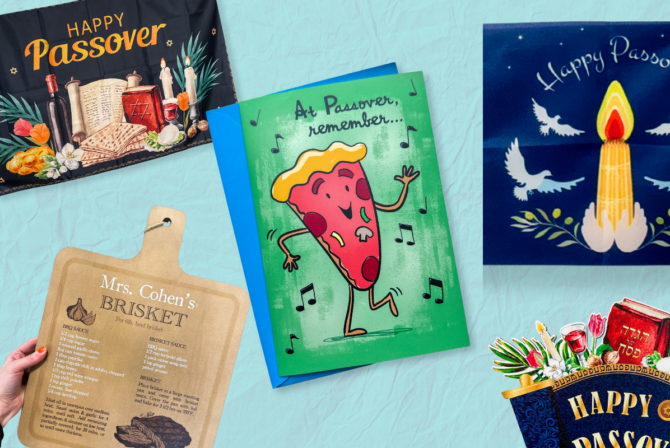One of my kids’ favorite books is called, “Here Comes Shabbos.” It’s a beautifully written and illustrated children’s book, which goes through a Friday in a religious home. The Imma (mom) bakes the challah and cakes while the children play on the floor, and then she shops for her food and cooks chicken soup and cholent. The Abba (dad) picks up the kids from school and they all go through their chores for getting ready for Shabbat—they shine their shoes, set the table, take baths, and talk to their Bubby and Zeidy. And then the Imma lights her beautiful silver candelabra, surrounded by her five children in beautiful Shabbat clothes, and the Abba leaves for synagogue.
You can almost feel the serenity in the air and the sense of purpose as the whole family happily prepares for Shabbat.
I have a love/hate relationship with that book.
Get Kveller's beautiful, step-by-step guide to experiencing Shabbat on your own terms. Order The Kveller Shabbat Guide here.
On one hand, to me this is what Friday is supposed to look like. And I want what this family has so badly that I feel compelled to try to make my home look like this.
On the other hand, I know it never will.
In their family, the Abba never gets annoyed that the kitchen is a mess while the Imma is cooking—because, wait, it isn’t messy. Somehow she does all of her shopping, cooking, and baking on one day—with two little kids crawling around—and there’s no mess. Her children don’t argue about who gets to set the table and who gets to decide what shape the napkins will be rolled into. The Imma doesn’t have to chase anyone into the bath. Aren’t the kids ever hungry and want a snack… which they will get all of their beautiful Shabbat clothes?
My house doesn’t look like that on Friday. Yes, the house is filled with delicious smells and the sounds of Jewish music playing as we all go through our chores to get ready for Shabbat. There is certainly a sense of anticipation in the air. But after shopping and cooking all day, my kitchen looks like a tornado ran through it. When I pick my kids up from school, I am covered in flour and whatever else I cooked that day. When I make homemade challah, they never rise (I am challah-deficient. I’ve accepted it. Rhodes dough balls makes a lovely challah). And my kids argue every single week about who gets to sit next to me (despite the fact that they were both upset at me before for yelling at them a third time to get. Into.the.bath. NOW) and while they are busy arguing, my baby is dragging the toilet brush all over the just-cleaned floors.
So this lovely book makes me feel as guilty as it makes me wistful for a reality that doesn’t exist—at least, certainly not for me.
But a few months ago, someone said something to me that has changed my view of Shabbat entirely.
It was actually a smooth Friday. The kids showered and dressed without issue and my kitchen was clean (miracles do happen). I lit the candles while holding my 2-year-old son who was imitating the waving gesture with his chubby hands. For once, Shabbat came in resembling the house in “Here Comes Shabbos.” We sat down at our beautifully set table, the silver gleaming, the sprinkled challah (I have three daughters—it’s a must) looked inviting. There was no fighting about who sits next to who. My company sat down and as they looked at the soup and the brisket and the chicken, the kugels and the salads waiting to be served, the wife said, “This is beautiful. But there is no way I can find time to cook and clean and prepare like this every week.”
And with that, Shabbat was deemed as “not for them.”
Her words reminded me about a very important lesson; that “Here Comes Shabbos” is one version of Shabbos, but it is most certainly not the definition of what Shabbat is supposed to look like.
Shabbat is when we have a table-full of company and everyone is dressed in their finest, and we eat and laugh and talk until late at night.
Shabbat is also when we are exhausted from the week and we all sit at the table in fuzzy pajamas (OK, my husband would never do this but on occasion, the rest of us do) and eat chicken, Near East rice, and Duncan Heines brownies for dessert. And that’s it.
Shabbat is sitting on the couch together as a family while we all read books quietly to ourselves.
Shabbat is when I revisit my childhood and find myself playing Monopoly and Rummikub and Uno with my kids. It is when I find out what’s going on in school and listen as my kids proudly share what they have learned about the weekly Torah portion and I don’t have a phone to distract me from giving them my full attention.
Shabbat is when I am standing by the candlelight and know that whatever stresses I had on my head all week are suspended—at least for 25 hours—because there isn’t much I can do about them now, anyway. Shabbat gives me the perspective that there’s more to life than how much I can accomplish in a day and that my hard work isn’t worth all that much if I don’t take some time to reflect about my direction and purpose.
Shabbat is embracing my imperfection and realizing that it’s OK to mess up, as long as I’m striving to be better. Shabbat is remembering that I don’t live for the outside world—because glowing Facebook pictures and statuses don’t define my life—but rather it is my personal self-reflection and hard work.
And Shabbat is realizing that however it happens—whether my kitchen is messy or sparkling, my food is plentiful or sparse, my kids perfect angels or… not—every Shabbat is beautiful and exactly as it’s supposed to be.
Read More:
10 Hosting Hacks to Make Shabbat Dinner Easier
This Is What Going to Therapy Made Me Realize
We Need to Talk About the Suicide of Bullied 12-Year-Old Evan Ziemniak







